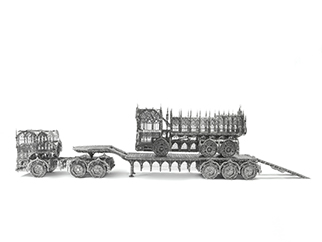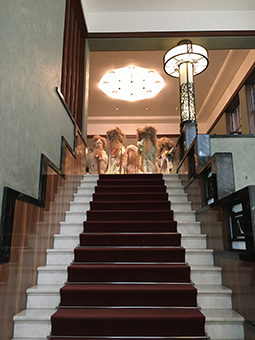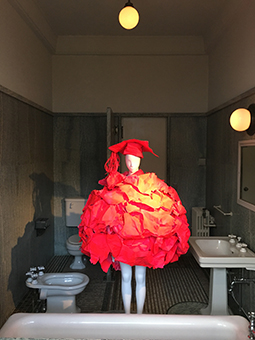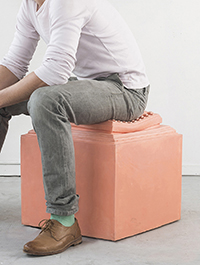 |
Focus features two in-depth reviews each month of fine art, architecture and design exhibitions and events at art museums, galleries and alternative spaces around Japan. The contributors are non-Japanese residents of Japan. |
|
|
 |
 |
 |
Understanding the Timeless Art of Decoration
James Lambiasi |
 |
Salon of the Prince Asaka Residence, Tokyo Metropolitan Teien Art Museum. |
Normally when we refer to "decoration," we use the word in the ornamental sense, such as the decorating of a Christmas tree or a wedding cake. The Merriam-Webster Online Dictionary defines decoration as "something that adorns, enriches, or beautifies." The fact is, however, that decoration is so ubiquitous that we tend to forget it permeates our lives to such a degree that it is invisible. If we view decoration as any gesture that goes beyond pure functional necessity, we can understand that there is virtually nothing in our lives that has not been formed, crafted, or designed by an outside hand. Interestingly, when we honor a type of decoration we refer to it as an art, but the reality is that decoration transcends art by permeating and contextualizing our everyday lives. The act of decorating is timeless, and as such provides the theme of the current exhibition at the Tokyo Metropolitan Teien Art Museum, Decoration never dies, anyway.
The exhibition creates a lens through which we can understand this notion of decoration via exhibits by seven different artists, varying in age and nationality, that address decoration through their own artistic processes. While the broad variety of exhibits provides a comprehensive reading of this theme, the physical interior of the main building of the Teien Art Museum itself enriches the context further. Built in 1933 for a member of the imperial family, Prince Asaka, this gem of Art Deco architecture has been serving as a museum since 1983. By viewing these exhibits within such a luxuriously decorative environment, our perception of how decoration permeates our lives is further heightened and we are challenged to contemplate its deeper meaning.
 |
 |
 |
|
Wim Delvoye, Flatbed Trailer (2014) and Dump Truck (2012).
Photo © Studio Wim Delvoye, Belgium |
 |
Wim Delvoye, Rimowa Classic Flight Multiwheel 971.73.00.4 (2015).
Photo by James Lambiasi |
The works of Belgian artist Wim Delvoye isolate the extravagance of intricate decoration by juxtaposing them with the mundane. Flatbed Trailer and DumpTruck are everyday vehicles, yet reinterpreted through painstakingly crafted laser-cut aluminum details of Belgian Gothic cathedrals. In another exhibit, Delvoye transforms a Rimowa suitcase into a fetishized ornament of hammered aluminum.
While the clothing of Japanese fashion designer Yoshikazu Yamagata certainly transforms the human body through his magnificently extravagant designs, the clever use of setting also reveals his ability to transform space. As one ascends the grand marble staircase to the second floor, one might wonder what the former resident, Prince Asaka, would think about the top landing occupied by a confronting throng of mannequins in swirling wisps of hair and sheer cloth. In another dramatic example of Yamagata's work, the setting of a single mannequin creates a surreal scene in the original bathroom -- that of a dress resembling a smoldering red sun resting between the porcelain toilet and sink.
 |
 |
 |
|
Yoshikazu Yamagata, from The Fashion Show of the Gods, 2010 SS collection (2017 update).
Photo by James Lambiasi |
 |
Yoshikazu Yamagata, from Graduate Fashion Show -0points-, 2009 AW collection (2017 update).
Photo by James Lambiasi |
Working as an artistic team, twins Akiko and Masako Takada from Japan adeptly turn everyday objects into pieces of art. In Cut Glass, typical suction cups made of clear soft plastic are transmuted into brilliant glass crystal objects simply by applying traditional kiriko Japanese glass-cutting techniques. The subtle humor of the twins is further evident in Leaf, in which the leaf patterns of the tablecloth in the family dining room stray outside the cloth border and are found lightly accumulating on the floor below.
Akiko & Masako Takada, Cut Glass (2014) at left and Leaf (2015) at right. Photos by James Lambiasi |
|
 |
|
|
|
Nynke Koster, Elements of Time (2014) (2017 reproduction). Photo by David in den Bosch
|
In Elements of Time, Dutch artist Nynke Koster uses architectural interior details to create rubber molded copies. The juxtaposition of the antique building ornamentation with the soft, swirling texture of rubber not only allows us a new perspective, but further enhances the reinterpretation by inviting us to touch and sit upon the cushiony surface.
With each exhibit presented in the museum, we are challenged with a new reading of the timelessness of decoration as each artist explores his or her own materials and techniques. Yet comparisons between these seven artists would not be as meaningful were it not for the underlying threads of commonality that bind all of the works into one poignant message. Each artwork is a product of ingenuity and exploration, diligently crafted to reinterpret and convey the message that decoration is an innate characteristic of our human nature, and that indeed, "decoration never dies, anyway."
All images reproduced by permission of the Tokyo Metropolitan Teien Art Museum.
|
 |
 |
James Lambiasi
Following completion of his Master's Degree in Architecture from Harvard University Graduate School of Design in 1995, James Lambiasi has been a practicing architect and educator in Tokyo for over 20 years. He is the principal of his own firm James Lambiasi Architect, has taught as a visiting lecturer at several Tokyo universities, and has lectured extensively on his work. James served as president of the AIA Japan Chapter in 2008 and is currently the director of the AIA Japan lecture series that serves the English-speaking architectural community in Tokyo. He blogs about architecture at tokyo-architect.com. |
|
 |
|